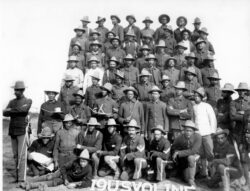Silent No More
Uncovering Black history in Iberia Parish
Published: August 31, 2023
Last Updated: November 30, 2023

Phebe Hayes
The Bandit Chasers, 1899. Wakefield is at furthest left, with mustache.
Hayes founded IAAHS in 2017 with the mission to unveil the storied and rich history of African Americans in Iberia Parish. The IAAHS Center for Research and Learning, located on the second floor of the Shadows-on-the-Teche Visitor Center, builds on this mission through presenting public programs, digitizing primary documents, and maintaining a small archive that is physically and virtually available to scholars, researchers, and educators. The IAAHS Center for Research and Learning uses a community-based approach to collect historical content from parish locals, allowing staff to employ professional curatorial skills while also listening to the needs of the community, resulting in an interpretive strategy that reflects the values of both contributors and curators. The healing practice of listening to community stories and allowing the community to present its history unencumbered pushes back against the previous erasure of African American history in Iberia Parish. Contributors to the IAAHS Center for Research and Learning can keep their physical items and digital files, with the option of allowing the center to add the digital records to its collections, furthering opportunities for conversation and interpretation.
The healing practice of listening to community stories and allowing the community to present its history unencumbered pushes back against the previous erasure of African American history in Iberia Parish.
Cheylon Woods, director of the Ernest J. Gaines Center at the University of Louisiana at Lafayette, noted that at many traditionally curated museums, “Lack of representation [created] spaces that silently continued to reenforce negative connotations and racist ideas.” In contrast, the central focus of the research center is inclusivity, and its curatorial approach is inspired in part by the 1960s Black Museum Movement, which foregrounded experiential learning and everyday objects such as quilts, pots, and brushes to convey community history and spark conversations about identity, race, and politics.
Many African Americans in New Iberia are descendants of people formerly enslaved at Shadows-on-the-Teche, the plantation located just across the street from the Center for Research and Learning. It is especially important that the town’s Black community is involved in the center’s activities, and that their past is reflected with dignity and humanity. Through community contributions, the center’s digital archive will grow to display a variety of donors’ personal belongings that are rich with memories and messages of survival. These digital records hold the voices of a vibrant community that was never silenced by the violence of the Reconstruction or Jim Crow eras.
In October 2022 center intern Breighlynn Polk used oral history recordings of interviews with community elders, collected nearly thirty years prior by high school students across the parish, to craft her dissertation, “The Second Side: A Historic Retelling of African American Life in Iberia Parish, Louisiana.” A related exhibit reunited former teachers, students, community leaders, and more to commemorate the project and those who have passed but whose voices continue to echo through Iberia Parish.While the IAAHS Center for Research and Learning emphasizes the collection of records related to African American history, the center also collects and digitizes records owned by people of various ethnic backgrounds, especially records that help provide context for the parish’s history. The center has digitized a collection of plantation ledgers from a Jeanerette plantation. Students at the University of Louisiana at Lafayette used the ledgers to complete capstone projects on Iberia Parish’s Black Civil War veterans and the day-to-day activities of recently freed Black people working in a plantation store during and after Reconstruction.
The center currently has five collections: Black Civil War Veterans in Iberia Parish, IAAHS Collection, Loisel Plantation Ledgers Collection, Shadows Photo Collection, and I. A. Martin Photo Collection. Each enriches the historical record of Iberia Parish. Their inclusion insists on acknowledging the humanity of people whose presence had often been excluded from historic texts but who remain essential contributors to the culture and vitality of the parish.
Jordan J. Richardson, public historian, is currently the head of digital collections at The IAAHS Center for Research and Learning in New Iberia, Louisiana. Richardson has worked in archiving and museum collections management. He received his masters in 2018 from UL Lafayette and is a 2014 LSU graduate. Richardson is a native of Morgan City, Louisiana.
